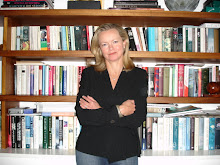
Jitish Kallat (b.1974) "Public Notice 2" (2007) - this image copyright: Saatchi Gallery
It is 25 years since bashful advertising maven Charles Saatchi opened his first gallery in a disused paint factory in north London. Saatchi has since courted controversy and divided the critics with his potent, some might say, baleful, patronage. However, signs are emerging that the art market Melmotte may finally be mellowing. The gallery is now in its third incarnation and some distinctly philanthropic elements are appearing, alongside the taciturn collector’s once rather more commercial objectives.
In 2003, the Saatchi Gallery left leafy St Johns Wood, migrating south to London’s former County Hall. However, the sojourn on the South Bank was ill-starred to say the least, overshadowed by rows over tenancy and an acrimonious war of words with the YBAs Saatchi had once championed and their nominal gang leader, Damien Hirst.
I personally never felt many of those period icons, such as Damien’s Shark, Gavin Turk’s Sid Vicious and Ron Mueck’s Angel seemed entirely at ease, among the wood panelled corridors and chambers of the palatial former GLC building. The Japanese landlords eventually won their legal case; Saatchi was evicted – it may well have been for the best.
The Saatchi Gallery reopened in October 2008 in the rather more elegant, grander setting of the former Duke of York’s Headquarters, upstream from Westminster, off the King’s Road in Chelsea. The shiny new floors have now finally settled down, the white walls no longer reek of fresh paint and a decent café is now also open.
The latest, and third major, show seems to have Saatchi continuing to monitor the geo-political and economic shifts which have marked the 21st century. The first exhibition showcased new art from China, the second, young Middle Eastern artists and now we have “The Empire strikes back: Indian Art Today” (29 Jan.-7 May 2010).
Aside from the dubious, gimmicky titles: “The Revolution Continues” for China; “Unveiled” for the Middle East, the shows have been critically well-received while art-loving natives and tourists alike now have another airy place of pilgrimage, with a growing reputation for thoughtful shows. Admission is also free.
The curators of the current show take advantage of the venue’s extraordinary spaces. To date, Gallery One has been used for a single or pair of powerful installations and is here given over to "Public Notice 2" (2007) by Jitish Kallat (above). There is an awful lot of Kallat, current darling of the sub-Continental art scene, on show here. Yet I had to admit every piece had earned its place. Unsurprisingly, practically every work on show here references socio-economic themes: poverty; violence; the gap between rich and poor.
Kallat’s monumental sculpture of the boy book seller “Eruda” (2008) is stunningly displayed here. Yet I found “Death of Distance” (2007) far more moving. The work comprises another huge sculpture, of a one rupee coin and five lenticular prints which juxtapose two found texts – one of a girl who commits suicide for want of one rupee for school lunch and the other on the launch of one-rupee-per-minute phone rates. Do take the time to read both stories. Kallat talks more about his work here.

Subodh Gupta (b.1964) "Spill" (2007) - this image copyright: Saatchi Gallery
At the 2005 Venice Biennale, I found Subodh Gupta’s installations of cooking pots and utensils both insubstantial and banal. In this setting, really rather more intimate than the always chilly and gloomy Arsenale, I found more to admire in the clever distortions of scale and in the still life oil paintings of the same steel cans and pans.
Another artist benefitting from intelligent installation was Pakistani artist Huma Mulji. Her taxidermied animal sculptures are not easy on the eye but the discomfiture they provoke is balanced by a marked humour.

Huma Mulji (b.1970) "Her Suburban Dream" (2009) - this image copyright: Saatchi Gallery
On show in the gallery’s Project Room is an on-going work by American artist Emily Prince (b.1981), entitled “American Servicemen And Women Who Have Died In Iraq and Afghanistan (But Not Including The Wounded, Nor The Iraqis Nor The Afghans). This highly topical contemporary comment-cum-tribute is overwhelming in scope. I will be revisiting this piece, and examining new works of war art by Prince’s contemporaries in a future post.
Last but far from least, Chelsea boasts another pull with the recent unveiling of Richard Wilson’s “20:50” – a site-specific installation of used sump oil and steel, first shown in the original Boundary Road gallery in 1987. This truly extraordinary experience now occupies an entire gallery, built specifically for the piece. The artist (b.1953) will discuss his work with critic Ossian Ward at the gallery on Thursday 25th February.




